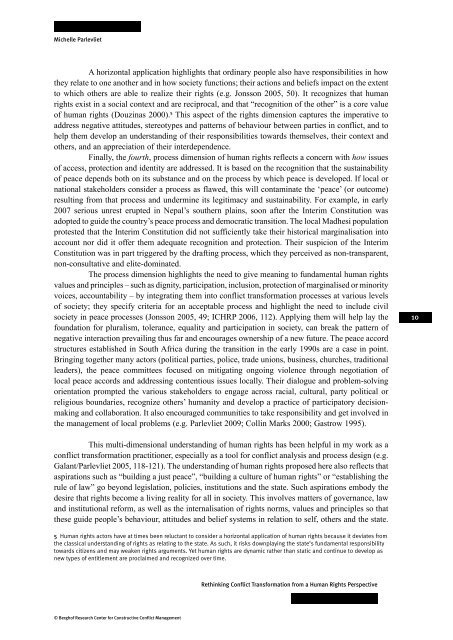Rethinking Conflict Transformation from a Human Rights Perspective
Rethinking Conflict Transformation from a Human Rights Perspective
Rethinking Conflict Transformation from a Human Rights Perspective
Create successful ePaper yourself
Turn your PDF publications into a flip-book with our unique Google optimized e-Paper software.
Michelle Parlevliet<br />
A horizontal application highlights that ordinary people also have responsibilities in how<br />
they relate to one another and in how society functions; their actions and beliefs impact on the extent<br />
to which others are able to realize their rights (e.g. Jonsson 2005, 50). It recognizes that human<br />
rights exist in a social context and are reciprocal, and that “recognition of the other” is a core value<br />
of human rights (Douzinas 2000). 5 This aspect of the rights dimension captures the imperative to<br />
address negative attitudes, stereotypes and patterns of behaviour between parties in conflict, and to<br />
help them develop an understanding of their responsibilities towards themselves, their context and<br />
others, and an appreciation of their interdependence.<br />
Finally, the fourth, process dimension of human rights reflects a concern with how issues<br />
of access, protection and identity are addressed. It is based on the recognition that the sustainability<br />
of peace depends both on its substance and on the process by which peace is developed. If local or<br />
national stakeholders consider a process as flawed, this will contaminate the ‘peace’ (or outcome)<br />
resulting <strong>from</strong> that process and undermine its legitimacy and sustainability. For example, in early<br />
2007 serious unrest erupted in Nepal’s southern plains, soon after the Interim Constitution was<br />
adopted to guide the country’s peace process and democratic transition. The local Madhesi population<br />
protested that the Interim Constitution did not sufficiently take their historical marginalisation into<br />
account nor did it offer them adequate recognition and protection. Their suspicion of the Interim<br />
Constitution was in part triggered by the drafting process, which they perceived as non-transparent,<br />
non-consultative and elite-dominated.<br />
The process dimension highlights the need to give meaning to fundamental human rights<br />
values and principles – such as dignity, participation, inclusion, protection of marginalised or minority<br />
voices, accountability – by integrating them into conflict transformation processes at various levels<br />
of society; they specify criteria for an acceptable process and highlight the need to include civil<br />
society in peace processes (Jonsson 2005, 49; ICHRP 2006, 112). Applying them will help lay the<br />
foundation for pluralism, tolerance, equality and participation in society, can break the pattern of<br />
negative interaction prevailing thus far and encourages ownership of a new future. The peace accord<br />
structures established in South Africa during the transition in the early 1990s are a case in point.<br />
Bringing together many actors (political parties, police, trade unions, business, churches, traditional<br />
leaders), the peace committees focused on mitigating ongoing violence through negotiation of<br />
local peace accords and addressing contentious issues locally. Their dialogue and problem-solving<br />
orientation prompted the various stakeholders to engage across racial, cultural, party political or<br />
religious boundaries, recognize others’ humanity and develop a practice of participatory decisionmaking<br />
and collaboration. It also encouraged communities to take responsibility and get involved in<br />
the management of local problems (e.g. Parlevliet 2009; Collin Marks 2000; Gastrow 1995).<br />
This multi-dimensional understanding of human rights has been helpful in my work as a<br />
conflict transformation practitioner, especially as a tool for conflict analysis and process design (e.g.<br />
Galant/Parlevliet 2005, 118-121). The understanding of human rights proposed here also reflects that<br />
aspirations such as “building a just peace”, “building a culture of human rights” or “establishing the<br />
rule of law” go beyond legislation, policies, institutions and the state. Such aspirations embody the<br />
desire that rights become a living reality for all in society. This involves matters of governance, law<br />
and institutional reform, as well as the internalisation of rights norms, values and principles so that<br />
these guide people’s behaviour, attitudes and belief systems in relation to self, others and the state.<br />
5 <strong>Human</strong> rights actors have at times been reluctant to consider a horizontal application of human rights because it deviates <strong>from</strong><br />
the classical understanding of rights as relating to the state. As such, it risks downplaying the state’s fundamental responsibility<br />
towards citizens and may weaken rights arguments. Yet human rights are dynamic rather than static and continue to develop as<br />
new types of entitlement are proclaimed and recognized over time.<br />
© Berghof Research Center for Constructive <strong>Conflict</strong> Management<br />
<strong>Rethinking</strong> <strong>Conflict</strong> <strong>Transformation</strong> <strong>from</strong> a <strong>Human</strong> <strong>Rights</strong> <strong>Perspective</strong><br />
10
















